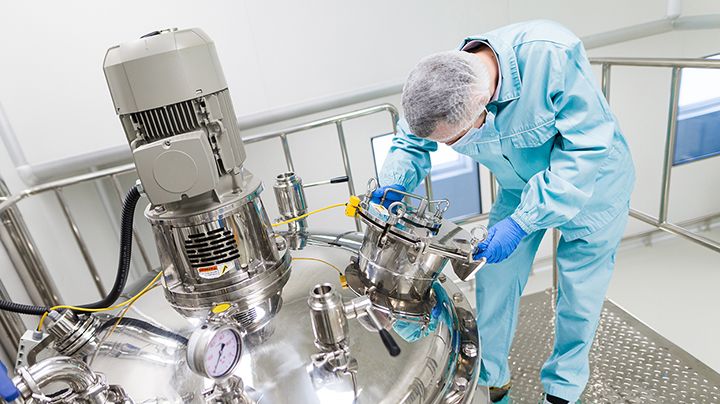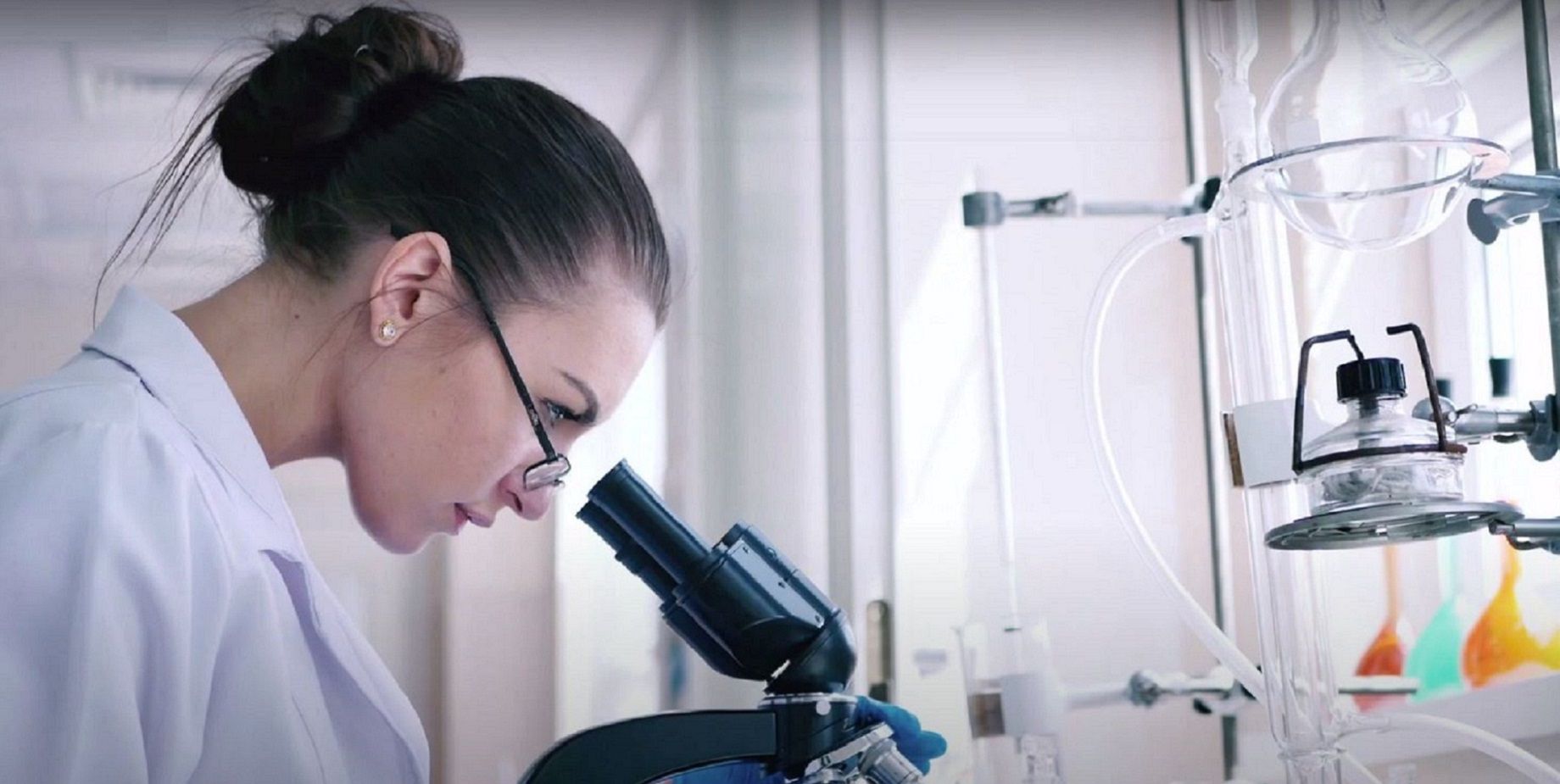Purification of Small Molecule Drugs
Polymeric resins for the purification of small molecule active pharmaceutical ingredients (APIs).
Purify vitamins, steroids, and aminoglycoside and beta-lactam antibiotics
Small molecule drugs have been the mainstay of the conventional pharmaceutical industry for generations. These small molecule active pharmaceutical ingredients (APIs) can be made by organic synthesis methods or microbial fermentation. Small molecule APIs include vitamin C, steroids, and aminoglycoside and beta-lactam antibiotics. Polymeric resins play an important role in purifying generic drugs and custom APIs. Resins can be used in adsorption mode or in ion exchange chromatography columns to:
- Purify raw materials
- Remove impurities caused by side reactions and degradation processes
- Eliminate processing materials
- Decolorize drug streams
Small molecule drugs are critical to patient health care and mainly target diseases with large patient populations. Therefore, it is important for resin suppliers to have the manufacturing scale and global reach to serve this market. DuPont has a long history of manufacturing polymeric resins at large volumes with consistent performance batch after batch. Our team is experienced with global logistics and our technical and regulatory support is available around the world to help through all stages of drug development from small molecule drug discovery to process scale-up and commercial manufacturing.
Purification solutions for small molecule drugs
Purification of small molecule drugs made by microbial fermentation routes
Microbial fermentation processes tend to produce complex mixtures with a wide variety of impurities. The capture-concentrate step serves as a first cut of the purification to knock down the impurity level to a point that is easier to manage in the following purification steps. Capture-concentration may be done in a simple stirred tank operation or in a flow-through mode using a chromatography resin. Stirred-tank mode is preferred for low-purity feeds that tend to foul in a packed resin column. In both processes, the target product is eluted from the resin with higher purity and higher concentration.
DuPont™ AmberChrom™ fine mesh ion exchange resins and DuPont™ AmberLite™ ion exchange resins are solutions for separations based on charge or pKa. DuPont™ AmberLite™ XAD™ adsorption resins are options for separations based on difference in hydrophobicity.
View all products for capture-concentrate in our product finder.
Remove drug-related impurities with ion exchange chromatography and reversed phase chromatography
Side reactions and degradation processes can create impurities that resemble the target drug species. These impurities can be very difficult to remove given their chemical and physical similarity to the product. Chromatography is a common technique to remove these challenging impurities. The chemical structure of the impurities and the target drug determine they type of chromatography best suited for the purification.
Ion exchange chromatography using DuPont™ AmberChrom™ fine mesh ion exchange resins can be an excellent way to purify a drug when the impurities have different charges than the target. For molecules without charges, a chromatography route based on differences in hydrophobicity, like reversed phase chromatography, is preferred. DuPont™ AmberChrom™ chromatography resins are more stable in terms of pH and can better withstand aggressive clean-in-place procedures than C18 silica in reversed phase high pressure liquid chromatography (RP HPLC) applications.
View all products for chromatography in our product finder.
pH Adjustment without Liquid Acid or Base for Sensitive Small Molecule Drugs
Drug companies often need to adjust pH when manufacturing a small molecule API. In many cases, using mineral acids and bases is the most cost-effective way to adjust pH. However, there are sometimes benefits to using an ion exchange resin instead. DuPont™ AmberChrom™ fine mesh ion exchange resins are excellent choices for adjusting pH without diluting the drug stream or introducing additional salts to the system.
View all product data sheets for pH adjustment in our resource center.
Remove metal catalyst impurities with DuPont™ AmberChrom™ fine mesh ion exchange chromatography resins
Pharmaceutical processes require stringent purity standards on raw materials. However, many incoming raw materials have residual impurities from the manufacturing processes that drug companies must remove. For example, residual catalysts may contain metals that could catalyze side reactions, reduce shelf life, or cause toxic effects in humans. DuPont™ AmberChrom™ fine mesh ion exchange chromatography resins can be used as scavengers to remove many residual metal catalysts such as palladium or ruthenium.
Remove detergents used for product recovery, viral inactivation, or endotoxin reduction
Drug safety is important, and manufacturers use techniques like viral inactivation and endotoxin reduction to ensure their products are safe. Surfactants can destroy viruses and reduce endotoxin levels, but they must be removed from the drug substance before it can be used. Generally, ion exchange chromatography is an effective technique for removing anionic, cationic, or zwitterionic surfactants, while polymer adsorbent resins, like DuPont™ XAD™ adsorbent resins, are effective at removing non-ionic surfactants. These resins can also be used to remove surfactants used to enhance product recovery from microbial fermentation broths.
View all product data sheets for polishing in our resource center.
Desalting small molecule drugs with DuPont™ AmberChrom™ Fine Mesh Ion Exchange Chromatography Resins and AmberLite™ XAD™ Adsorbent Resins
Salt is used in drug manufacturing to change the solubility of drugs, alter their reactivity, or increase the growth of microbes in fermentation. Salt composition and salt content often change throughout the manufacturing process as the salt balance for each production step can vary. Consequently, many process steps require a desalting step to remove residual salts.
AmberChrom™ fine mesh ion exchange resins can be used to remove salt from drug streams. There are two types of resins available for salt removal, cation-exchange, and anion-exchange, which come in different levels of crosslinking. This provides different degrees of swelling to accommodate high-capacity binding of solutes of various sizes. DuPont™ AmberLite™ XAD™ adsorbent resins can also be used for desalting. The AmberLite™ XAD™ resin adsorbs the product, allowing the salts to be rinsed away.
View all products for desalting in our product finder.
-
Capture-Concentrate
Purification of small molecule drugs made by microbial fermentation routes
Microbial fermentation processes tend to produce complex mixtures with a wide variety of impurities. The capture-concentrate step serves as a first cut of the purification to knock down the impurity level to a point that is easier to manage in the following purification steps. Capture-concentration may be done in a simple stirred tank operation or in a flow-through mode using a chromatography resin. Stirred-tank mode is preferred for low-purity feeds that tend to foul in a packed resin column. In both processes, the target product is eluted from the resin with higher purity and higher concentration.
DuPont™ AmberChrom™ fine mesh ion exchange resins and DuPont™ AmberLite™ ion exchange resins are solutions for separations based on charge or pKa. DuPont™ AmberLite™ XAD™ adsorption resins are options for separations based on difference in hydrophobicity.
View all products for capture-concentrate in our product finder.
-
Chromatographic Separation
Remove drug-related impurities with ion exchange chromatography and reversed phase chromatography
Side reactions and degradation processes can create impurities that resemble the target drug species. These impurities can be very difficult to remove given their chemical and physical similarity to the product. Chromatography is a common technique to remove these challenging impurities. The chemical structure of the impurities and the target drug determine they type of chromatography best suited for the purification.
Ion exchange chromatography using DuPont™ AmberChrom™ fine mesh ion exchange resins can be an excellent way to purify a drug when the impurities have different charges than the target. For molecules without charges, a chromatography route based on differences in hydrophobicity, like reversed phase chromatography, is preferred. DuPont™ AmberChrom™ chromatography resins are more stable in terms of pH and can better withstand aggressive clean-in-place procedures than C18 silica in reversed phase high pressure liquid chromatography (RP HPLC) applications.
View all products for chromatography in our product finder.
-
pH Adjustment
pH Adjustment without Liquid Acid or Base for Sensitive Small Molecule Drugs
Drug companies often need to adjust pH when manufacturing a small molecule API. In many cases, using mineral acids and bases is the most cost-effective way to adjust pH. However, there are sometimes benefits to using an ion exchange resin instead. DuPont™ AmberChrom™ fine mesh ion exchange resins are excellent choices for adjusting pH without diluting the drug stream or introducing additional salts to the system.
View all product data sheets for pH adjustment in our resource center.
-
Polishing
Remove metal catalyst impurities with DuPont™ AmberChrom™ fine mesh ion exchange chromatography resins
Pharmaceutical processes require stringent purity standards on raw materials. However, many incoming raw materials have residual impurities from the manufacturing processes that drug companies must remove. For example, residual catalysts may contain metals that could catalyze side reactions, reduce shelf life, or cause toxic effects in humans. DuPont™ AmberChrom™ fine mesh ion exchange chromatography resins can be used as scavengers to remove many residual metal catalysts such as palladium or ruthenium.
Remove detergents used for product recovery, viral inactivation, or endotoxin reduction
Drug safety is important, and manufacturers use techniques like viral inactivation and endotoxin reduction to ensure their products are safe. Surfactants can destroy viruses and reduce endotoxin levels, but they must be removed from the drug substance before it can be used. Generally, ion exchange chromatography is an effective technique for removing anionic, cationic, or zwitterionic surfactants, while polymer adsorbent resins, like DuPont™ XAD™ adsorbent resins, are effective at removing non-ionic surfactants. These resins can also be used to remove surfactants used to enhance product recovery from microbial fermentation broths.
View all product data sheets for polishing in our resource center.
-
Desalting
Desalting small molecule drugs with DuPont™ AmberChrom™ Fine Mesh Ion Exchange Chromatography Resins and AmberLite™ XAD™ Adsorbent Resins
Salt is used in drug manufacturing to change the solubility of drugs, alter their reactivity, or increase the growth of microbes in fermentation. Salt composition and salt content often change throughout the manufacturing process as the salt balance for each production step can vary. Consequently, many process steps require a desalting step to remove residual salts.
AmberChrom™ fine mesh ion exchange resins can be used to remove salt from drug streams. There are two types of resins available for salt removal, cation-exchange, and anion-exchange, which come in different levels of crosslinking. This provides different degrees of swelling to accommodate high-capacity binding of solutes of various sizes. DuPont™ AmberLite™ XAD™ adsorbent resins can also be used for desalting. The AmberLite™ XAD™ resin adsorbs the product, allowing the salts to be rinsed away.
View all products for desalting in our product finder.
Select publications using our products in small molecule drug applications
Colosimo, D.A., et al. (2019) Mapping Interactions of Microbial Metabolites with Human G-Protein-Coupled Receptors. Cell Host & Microbe 26 (2), 273-282. DOI: https://doi.org/10.1016/j.chom.2019.07.002
Poon, P.S., et al. Dowex 50WX4–100: An Efficient Catalyst for the Tetrahydropyranylation of Alcohols. Synthetic Communications, An International Journal for Rapid Communication of Synthetic Organic Chemistry 39(18), 3369-3377. DOI: https://doi.org/10.1080/00397910902774059
Chen, L.H., et.al. (2006) A reversed phase HPLC assay for the simultaneous quantitation of non-ionic surfactants in bioprocess intermediates. Journal of Pharmaceutical and Biomedical Analysis, 40 (4) 964-970. DOI: https://doi.org/10.1016/j.jpba.2005.08.033
Jain, R.P. et al. and R.M. Williams (2001) Asymmetric synthesis of (S)-(+)-carnitine and analogs. Tetrahedron 57(30) 6505-6509. DOI: https://doi.org/10.1016/S0040-4020(01)00542-7
Li et.al., (2001) Adsorption of Phenolic Compounds on Amberlite XAD-4 and its Acetylated Derivative MX-4” Reactive and Functional Polymers 49(3) 225-233. DOI: https://doi.org/10.1016/S1381-5148(01)00080-3
Stead, P., et al. (2000) Discovery of Novel Ansamycins Possessing Inhibitory Activity in a Cell-based Oncostatin M Signally Assay. The Journal of Antibiotics, 53(7), 657-663. DOI: https://doi.org/10.7164/antibiotics.53.657
Mahmoudian M., et al. (1998) A Versatile Procedure for the Generation of Nucleoside 5’-Carboxilic Acids using Nucleoside Oxides. Tetrahedron 54(28), 8171-8182. DOI: https://doi.org/10.1016/S0040-4020(98)00456-6
Chu, Alexander H. T. (1992) Process for Making Vancomycin US5149784, United States Patent Office. https://patentimages.storage.googleapis.com/ab/a7/9f/6d628731f3aebf/US5149784.pdf
Cartier, P.G., et al. (1990) The Utility of Polymeric Reversed Phase Packings for the Purification of Peptides, Proteins and Antibiotics in Pyle, D.L. (eds) Separations for Biotechnology 2. Springer, Dordrecht. DOI: https://doi.org/10.1007/978-94-009-0783-6_30
Want to try a product?
View the Small Molecule Drugs page of our e-store.
Explore other bioprocessing applications

We enable complicated separations for drug synthesis resulting in better outcomes for patients and life science companies.

Purification resins for PCR diagnostics, medical imaging, radiopharmaceuticals, and clinical diagnostics.

Design trityl-on and trityl-off oligonucleotide purification processes for high yield and high purity with DuPont™ AmberChrom™ Chromatography Resins.

Reverse phase HPLC and ion exchange chromatography for purification of insulin, vaccines, peptide antibiotics, and custom peptides.

DuPont™ AmberLite™ adsorption resins and ion exchange resins for isolating, purifying, and concentrating polyphenols, alkaloids, and heparin.
